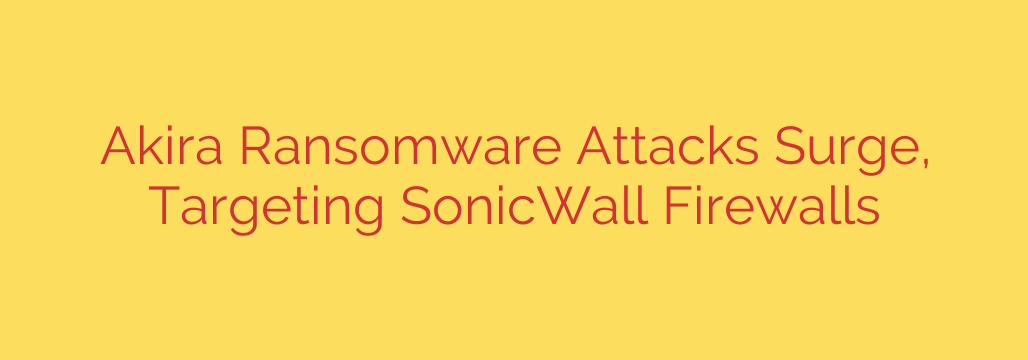
Akira Ransomware Exploits SonicWall Vulnerability: How to Protect Your Network
A significant wave of cyberattacks is actively targeting businesses, with the Akira ransomware group exploiting a critical vulnerability in widely-used networking hardware. If your organization uses SonicWall Secure Mobile Access (SMA) appliances for remote access, it’s crucial to take immediate action to protect your network from this escalating threat.
Cybersecurity researchers have identified a coordinated campaign by Akira, a notorious ransomware-as-a-service (RaaS) group, specifically targeting SonicWall SMA 100 series appliances. By exploiting unpatched vulnerabilities in these devices, attackers are bypassing the firewall to gain initial access to corporate networks, steal sensitive data, and deploy their file-encrypting malware.
How the Akira Attack Works
The attack chain is both sophisticated and effective, highlighting the importance of a multi-layered security approach. Here’s a breakdown of the typical attack progression:
Initial Compromise: The attackers scan the internet for vulnerable, internet-facing SonicWall SMA devices. Once an unpatched appliance is found, they exploit a known firmware vulnerability to gain a foothold within the network.
Credential Theft and Privilege Escalation: After gaining initial access, the attackers focus on stealing login credentials. Their goal is to find usernames and passwords for accounts that can be used to move deeper into the network.
Lateral Movement and Reconnaissance: Using the stolen credentials, the attackers move laterally across the network, identifying critical servers, databases, and backup systems. During this phase, they often disable security software to avoid detection.
Data Exfiltration and Encryption: Before deploying the ransomware, Akira operators engage in double-extortion tactics by first stealing large volumes of sensitive company data. Once the data is exfiltrated, they encrypt critical files across the network, bringing business operations to a standstill. The stolen data is then used as leverage, with threats to release it publicly if the ransom is not paid.
The Critical Role of Multi-Factor Authentication (MFA)
A key finding in these recent attacks is how the threat actors leverage compromised credentials. Reports indicate that accounts not protected by multi-factor authentication (MFA) are the primary targets for lateral movement.
Even if an attacker gains access to a valid username and password, having MFA enabled on all accounts—especially administrative and remote access accounts—acts as a powerful barrier. This simple security measure requires a second form of verification (like a code from a mobile app), which the attacker will not have. In many of the observed incidents, MFA could have stopped the attack from progressing beyond the initial breach.
Actionable Steps to Secure Your Network Now
Protecting your organization from this specific threat requires immediate and decisive action. Waiting until you see signs of an intrusion is too late. Follow these essential security recommendations:
- Patch Immediately: The most critical first step is to immediately update your SonicWall SMA firmware to the latest patched version. Manufacturers release security patches for a reason—failing to apply them leaves your front door wide open to known exploits.
- Enforce MFA on All Accounts: Ensure that MFA is enabled and required for all users, particularly for accounts with administrative privileges and for all remote access connections (VPN, RDP, etc.). This is no longer optional in today’s threat landscape.
- Disable Unnecessary Accounts: Review all user accounts within your system, especially on your firewall and VPN appliances. Disable any old or dormant accounts, including default vendor accounts that may not have been deactivated.
- Monitor for Suspicious Activity: Actively monitor network logs for unusual login patterns, access from strange IP addresses, or large, unexpected outbound data transfers. Early detection can make all the difference.
- Maintain and Test Offline Backups: Ensure you have a robust backup strategy that includes immutable or offline copies of your critical data. Regularly test your backups to confirm you can restore them quickly in the event of a ransomware attack. An offline backup is unreachable by an attacker on your live network.
The rise in Akira attacks against SonicWall appliances is a stark reminder that network perimeter devices are high-value targets for threat actors. Proactive security, diligent patch management, and a zero-trust mindset are essential to defending your organization against these relentless and costly attacks.
Source: https://www.bleepingcomputer.com/news/security/surge-of-akira-ransomware-attacks-hits-sonicwall-firewall-devices/








